The era of censorship Nintendo
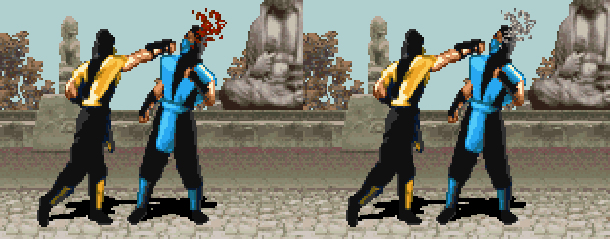
No blood on the Super Nintendo!
In the period between the end of the 80s and the mid-90s, video games bathed in the second wave of popularity in the US, and the only corporation dominated the market - Nintendo.
All popular video game systems were produced by Nintendo. The software for creating games owned by Nintendo. All games on store shelves must have been licensed by Nintendo. This overwhelming dominance bordered on monopoly, and in that era, Nintendo was indeed often sued for this particular crime .
Whatever we think about the “Era of Nintendo” in retrospect (and many of them don’t even think about it), but without a doubt, it remains a serious trace in the history of American gaming.
Realizing very well that many American parents of that time considered video games to be an ominous, child-corrupting force, in this era Nintendo of America (NOA) made the corporation's main priority to publish all games only under its banner, so that they contain only “family” themes and content. Although this did not contradict the views of consumers of the time, such moralizing pressure was considered to be one of the most notorious traditions of NOA.

Mortal Kombat in the news. With the growing popularity of video games, panic about their content has grown. Nintendo is tired of calming anxious parents.
Today, old video games are actively illegally downloaded and stored online, including the original Japanese versions that have never been released in America. The degree of severity of censorship and “softening” of the content of games imported from Japan by NOA is widely known and is a frequent topic of fierce online conversations. The “abusive” Japanese content of dozens of imported games (including a multitude of bestsellers) was deleted, edited or “ennobled”, in the name of super-conservative standards of decency of the Reagan era. Hints of smoking or sex were cut out, beer bottles were replaced with coffee cups, and splashes of blood with sweat drops, and so on. Games with even more offensive content could not get to the market at all. By the standards of the 21st century, most of this censorship looks extremely outdated or humiliating, especially from the point of view of Generation Y gamers, who can now look at their childhood from a new, more critical angle.
rules
Although it is fashionable to declare the principles of Nintendo censorship of the past decades, arbitrary or illogical, but in their madness was the method.
The following is the full text of the Nintendo of America Content Guidelines , quoted from the 1994 book The Stephen and Janet Schwartz 's Parent's Guide to Video Games . This document lists the basic rules governing the entire NOA censorship regime.
Nintendo of America Content Guidelines
[OK. 1994]
The main priority for Nintendo of America is to provide our customers with high-quality video game entertainment. If these buyers are children, then intervention in the gameplay of parents is recommended. Nintendo believes that our products do not contain materials that may be considered unacceptable from the point of view of society as a whole.
Therefore, since 1988, we have carefully checked the contents of all games developed for Nintendo systems for compliance with our changing standards. As business grows, we adapt our guidelines to the needs of our target age group and their parents. Although we are aware that the definitions of social, cultural and political views are very subjective, we continue to provide consumers with entertainment that reflect the norms acceptable to society.
The following Game Content Guidelines provide guidelines for developing approved game packages (i.e. game packages for Nintendo and its licensees) that define content types and topics that do not match Nintendo’s corporate and marketing philosophy. Although exceptions may be made to save game content, Nintendo will not approve games for NES, Game Boy and Super NES systems (for example, audiovisual works, packaging and user guides), in which:
• contains obscene or overt content, including rape and / or nudity; [one]
• contains texts or images that discriminate on the basis of sex; [2]
• demonstrates indiscriminate, unreasonable and / or excessive violence; [3]
• shows a graphic image of death; [four]
• demonstrates domestic violence and / or bullying; [five]
• demonstrates the excessive use of force in sports games, which is superior to the use in real contact sports; [6]
• Ethnic, religious, nationalistic or sexual stereotypes are reflected. including symbols relating to any kind of racial, religious, nationalist or ethnic group, such as crosses, pentagrams, God, gods (gods of ancient mythology are acceptable), Satan, hell, Buddha; [7]
• in any form foul language or obscenity is used, both in speech and in the form of gestures, which can be offended by violation of public standards and tastes; [eight]
• illegal drugs, smoking accessories and / or alcohol are used, and their use is promoted (Nintendo does not allow placement in arenas, stadiums, playing fields and fences in sports games advertising beer or cigarettes); [9]
• subconscious political ideas or explicit political statements are contained; [ten]
Comments:
Virtually each of the above rules, sooner or later, NOA was used to censor the content of different games.
I commented on the instructions of this policy with examples of how the rules were usually applied in practice. My examples are by no means exhaustive, but I hope they give an idea of the standard techniques. Much has been written on this topic, and for those interested, I’ll leave links with alternative examples at the end of the article.
Rule 1: "Nintendo will not approve games ... which contain obscene or frank content, including rape and / or nudity"
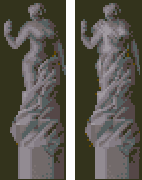
This nude statue from Super Castlevania IV (1991) was “dressed” in a release for the USA (on the right).
As any fan of Japanese pop culture can confirm, Japanese are usually quite liberal about images of nudity, sex, and other piquant content. In addition, video games in Japan are just as popular among adults as they are among children. Therefore, there was no shortage of games in which sexuality had to be weakened before the release of the United States.
Naked (or dressed in too frank outfits) characters of Japanese games NOA usually dressed. Even the “elegant nakedness” of classical paintings and the like was rarely resolved.
A demonstration, mention or hint of sex and sexual acts was, of course, forbidden. Character dialogues hinting about rape, prostitution, adultery, or homosexuality were removed, and ambiguities were usually replaced with much less dangerous jokes.
Rule 2: "Nintendo will not approve of the game ... which contain texts or images that discriminate on the basis of gender"
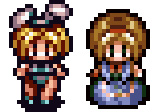
In the Japanese version of Lufia II: Rise of the Sinistrals (1995), women working in casinos were dressed like Rabbits from Playboy (left). In the American version they were dressed more conservatively (right).
Although Nintendo of America didn’t actually wage a full-scale war against sexism in video games, there have been many instances when NOA punished games in which images of women crossed the line between "sexuality" and "discrimination." Half-dressed female characters were often forced to “hide behind” before entering the American market, sexist nicknames or appeals were removed from dialogues, and, in some cases, hostile female characters in violent games were even replaced by men, due to the fear that American gamers are subject to the strictest taboo on the violence of men against women.
Much of the dubious content is rooted in cultural differences in the relationship between the sexes. In Japan, the culture of male chauvinism is much stronger than in the United States. To this day, Japanese society almost does not react negatively to the sexualized or passive image of women in the media.
Rule 3: "Nintendo will not approve of the game ... which demonstrates indiscriminate, unreasonable and / or excessive violence"
Although by today's standards it may look incredibly sentimental, but initially NOA had strict guidelines about acceptable and unacceptable forms of violence in video games. In essence, acts of cruelty should have been committed in the right context and against a suitable enemy. The battle of swords and knives was resolved, but only against equally well-armed opponents. It was impossible to attack civilian or friendly characters, as well as innocent animals. In most cases, firearms were allowed to be used only against robots and other inhuman creatures, such as aliens or zombies.

A pretty stupid description of what 1-Up does from the Mega Man 2 (1989) user manual.
The display of violence on the screen should also be stylized and non-offensive. When enemies die, their bodies must quickly disappear, and not wallow in decaying heaps. The implication was that these characters are not "dead", but simply "eliminated" from the game's universe, almost as much as the pieces are removed from the chessboard.
This is consistent with another NOA policy regarding death in games, namely, the words “death”, “die”, “kill” or “killed” are prohibited. In the Nintendo game guides and game dialogues, the “killing” of enemies was never mentioned, they were “defeated” or “destroyed”. Although the players talked about the character’s “lives”, the official text of the game called them “attempts” or “chances.”
Rule 4: "Nintendo will not approve of the game ... which shows a graphic depiction of death"
There was no blood in Nintendo games. If a character was shot, blood could not flow from his body, bowels could fall out, and so on.

From blood to sweat in Mortal Kombat.
This strict bloodless policy reached its peak with the release in 1992 of Mortal Kombat for SNES. The Mortal Kombat version for arcade machines has hit the headlines as one of the most extremely fierce games. It gave players the opportunity to pull the spine out of the body of the enemy, to pull out the pulsating organs from his chest, and the like. Such cruelty, of course, did not turn away the players at all, but made the game a huge hit.
However, when the game was ported to SNES the same year, players were disappointed that Nintendo had removed almost all the blood from it. Instead of blood, gray drops of “sweat” flew out of the bodies of the characters, and the disgustingly inventive “fatalities” were completely removed. The game failed in sales, especially compared to the success of the uncensored version of the Sega Genesis, which by that time had become the main rival of NOA in console video games. This incident caused Nintendo to gradually reduce video game violence.
Rule 5: "Nintendo will not approve of the game ... which demonstrates domestic violence and / or bullying"
In general, domestic violence in video games is not so much, because usually the action of games does not occur at home. But sometimes it happens.
In one episode of the Japanese role-playing game Mother 2 (1994), the father punishes his children for returning home later. He leads them off the screen, after which a “beating” noise is heard. If you then talk to one of these children, he will complain that he has a "sore butt." When Mother 2 was released in the USA (called Earthbound (1995)), the sound of the beating was replaced with the game noise “abuse”. Instead of complaining about his priest, the child whimpers that his father left him without sweets. Full comparison video can be viewed here .
Rule 6: "Nintendo will not approve of the game ... which demonstrates excessive use of force in sports games, superior use in real contact sports"
Most of the sports games were created in the USA, and therefore in the period under review almost all games were developed taking into account the NOA rules. I do not know about the existence of sports games, censored because of the "excessive use of force."
Rule 7: “Nintendo will not approve of the game ... which reflects ethnic, religious, nationalist or sex stereotypes”
This is an interesting rule, obviously, it was intended to protect NOA-approved video games from using racist, cultural or sexist appeals, which in science are usually referred to by the term “speech stereotypes”.

Typical Russian? Vodka Drunkenski from Punch-Out !!
It is difficult to find many examples of the explicit use of this rule, because basically cleaning up Japanese games from stereotypical phrases (if they were present) occurred at the localization stage from Japanese to English. Therefore, it is difficult for me, who does not speak Japanese, to study these cases.
One possible example is the renaming of the Russian character of the game Punch-Out !! (1984) Vodka Drunkenski in Soda Popinski (Sipinski's Soda) while transferring the game to America. Although it is obvious that rule 9, which prohibits the mention of alcohol, was the main motivation for this substitution, it is quite possible that the new name, at least in part, should have somewhat weakened the stereotypical display of the character as a “Russian drunkard”.
"Characters belonging to any kind of racial, religious ... group"
Here we encounter the most commonly used, and therefore the most notorious rule of NOA. Since this part of rule 7 dealt with work with potentially offensive images, examples of the application of this rule immediately become obvious to anyone who played in both the Japanese and American versions of the censored game.
“Like crosses”

Crosses on gravestones in DuckTales (1989) are replaced in the American release with “RIP”.
In today's endless cultural battles about the preservation of the mention of Christ (Christ) in the word Christmas and the like, it is strange to recall that there was a time in which the protection of Christianity from vulgar pop culture was a popular conservative position. NOA’s aggressive attempts to remove crosses from video games remain a fascinating confirmation.
In the era of censorship, images of crosses on graves, churches with a cross on top, Bibles with a cross on the cover and cruciform decorations were removed from the games before the release in the United States, which led to the appearance of empty spiers and tombstones that were strange for the American gamer. Even in the Castlevania franchise with a vampire theme (1987-), thanks to editing, the hero uses boomerangs, not crosses, to kill Dracula.
Sometimes it was believed that such a "crusade" caused the removal of Japanese images of red crosses from hospitals and first-aid kits. But most likely they did it because of copyright issues with the logo.
"God, the gods ... Satan, hell"
Other religion-related names and names also changed. In Final Fantasy III (1994), the magic spell “Holy” (“Holiness”) was given the nondescript name “Pearl” (“Pearl”).
Devils could appear in Nintendo games, but they could not be called by that name. Horned creatures have always been given names such as imps ("besyat") or demons ("demons"). Even the Mega Man franchise (1987-), often seen in the Yellow Devil (“Yellow Devil”) character, turned into a Rock Monster (“The Stone Monster”), despite the fact that he didn’t look like a traditional devil from Christianity at all (however, on a monster made of stones). In Secret of Mana (1993), the Hell Hound character (hell hound) for the release in the United States was rather defiantly renamed Heck Hound [heck is a euphemism for hell, like a gosh instead of God].
"Characters belonging to any kind of ... nationalistic or ethnic group"

Swastika on the Nazi flags from Bionic Commando replaced by German eagles.
In several popular American games, the enemies of all were villains, beloved by all, the Nazis, but NOA did not welcome the most terrible Aryan chauvinists as characters. The company wanted its games to have no explicit references to ethnic nationalism. Even if the game was used by the Nazis in a historical setting or context, the image of the swastika was forbidden. Like Adolf Hitler himself.
The game for NES Bionic Commando (1988) was completely different in Japan. There she was called Top Secret: The Resurrection of Hitler (1988). Initially, the plot of the game revolved around a group of neo-Nazis trying to revive Hitler, in order to further seize power over the world. When the game appeared in America, the main plot remained the same, only the Nazis turned into "Badds" (Badds), and Hitler became "Master D." (Master D.). Swastika cut out, but the appearance of Hitler remained the same.

Wolfenstein 3D. A poster with Hitler in the PC version (left) and a poster with “Staatsmeister” in the SNES version.
Wolfenstein 3D (1992) was a popular first-person shooter for the PC. The player controlled the Jewish avenger, making his way through the castle filled by the Nazis, and in the end he fought with the Fuhrer himself. These mentions of the Nazis were carefully cut from the port for SNES. Hitler became the “State Master” ( Staatmeister ), and all the swastikas were removed. As a result, only empty red flags remained in the castle.
Rule 8: "Nintendo will not approve games ... in which any form of foul language or obscenity is used"
NOA's decision to ban curses in games was probably one of the least controversial of its policies, and was rarely used. This was partly due to the fact that the old stereotype that the Japanese are very polite and they do not even have foul language is somewhat truthful. Terrific blogger-translator Clyde Mandelin notes in his post on this topic that the Japanese language has complex codes of communication with different classes, so the closest analogue to swearing is to refer to a person as a representative of a lower class.

The offensive posture of the winner Bowser (Bowser), reminiscent of the popular European gesture "bite" (left), was replaced in the American version of the Super Mario RPG (1996) (right).
If someone created shamelessly offensive content, it was the Americans themselves. For example, in the original film Who Framed Roger Rabbit (1998) there was a villain named Smart Ass. In the game adaptation for the NES he was given the name Smarty.
Obscene acts were performed a little more often, and there are several documented examples of how raised middle fingers and other rude gestures were removed from the gameplay.
Rule 9: "Nintendo will not approve games ... that use illegal drugs, smoking accessories and / or alcohol"
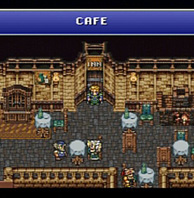
Various bars from the Japanese Final Fantasy VI (1994) in the American version, known as Final Fantasy III, were replaced by a "cafe".
Even in Japan, deliberate demonstration of illegal drugs in video games is not too common. I managed to find only one example of this: in the original version of Final Fantasy Legend II (1990) there was a gang smuggling in opium. In the American version (1991), they smuggled bananas. Almost the same serious crime, I think.
More often NOA punished for the appearance in the games of legal drugs, namely tobacco and alcohol. Before the release of the game in the US, cigarette smokers or cigars of the characters were cut out, and beer cans or wine glasses were removed or replaced with something more innocent, such as pops or coffee.
In addition, in Japanese games there were often bars that had to be replaced with cafes or snack bars.
Rule 10: "Nintendo will not approve the games ... which contain subliminal political ideas or explicit political statements"
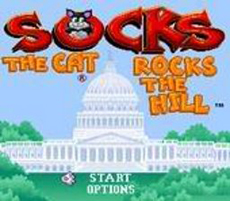
Socks the Cat Rocks the Hill remains one of the most mysterious and hazy of unpublished video games of the late 1990s.
This is probably one of the most rarely used rules, along with sports. It can be said without stretching that most Japanese video game programmers of the 1980s era did not know and were not interested in American political culture, and were not engaged in “subconscious” suggestion in games of political ideas (except the most obvious) that could affect the US audience.
In the previous version of this article, I outlined the idea that the unreleased game for the SNES of the mid-90s Socks the Cat Rocks the Hill (c. 1994) was canceled due to the fact that, according to some information, it contained evil caricatures of contemporary American politicians who acted as villains. Rumors about the cancellation of the game because of the content were rejected by the people involved in its development, but if there was ever a game that could break the tenth rule, then this may be Socks . Interestingly enough, Nintendo approved the American release of the game I'm Sorry (1985), in which there was a cautious satire on the supposedly kleptocratic style of government of the former Prime Minister of Japan, Tanaka Kakuei (1918-1993).
Afterword
By the mid-90s, censorship Nintendo put the company in an awkward position and adversely affected income. Nintendo has earned a reputation as a "childish" company, too caregiver and "toy" for adult gamers. It was at that very moment when maturing consumers had a demand for more “mature” games.
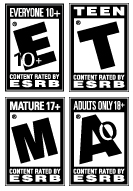
Designations ratings ESRB.
A kind of rescue appeared in 1994, when the organization Entertainment Software Rating Board (ESRB) was founded. The ESRB, created and maintained by the leading representatives of the industry itself, was an attempt to independently implement a single rating system for the entire American games market. Such a precautionary step towards corporate responsibility was needed to prevent the growing threat of tougher government rules. At that time, censorship of youth sources of information was supported by both parties and initiated by such politicians as Senator Joseph Lieberman.
Starting in 1996, every video game created for any video game system (not just Nintendo) had to be tested before the commercial release of content in the ESRB and get rated. KA rating means that the game is suitable for all ages, T for teenagers from 13 years old, and M for adults only. Ratings were assigned based on content analysis by an independent commission that assesses violence, obscenity, and sexualized images. The process resembled a similar one performed for American films.
The ESRB allowed NOA to gradually reduce its censorship and enter a wider market. Today, Nintendo of America does not actively censor games produced for its systems, and the responsibility for popularity in the market, depending on the ESRB rating, lies with the independent game creators.
In 2011, the US Supreme Court decided on the case of Brown v. Entertainment Merchants Association , in which it recognized as unconstitutional the introduction by the states of laws prohibiting the sale of "adult" games to children who want to play them. ESRB ( ), , . .
All Articles